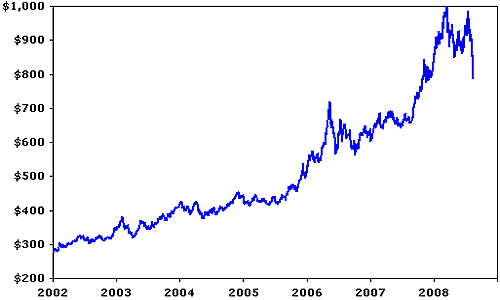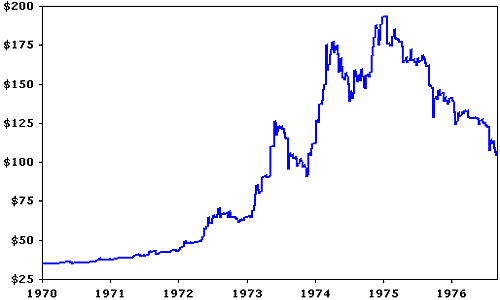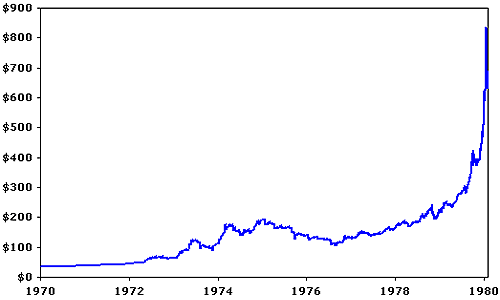| Home | About Us | Resources | Archive | Free Reports | Market Window |
What's Next for Your Gold Investment?By
Tuesday, August 19, 2008
Gold is down 20% from its highs... So what should we do? What's next for gold? Gold peaked at around $1,000 an ounce in March of this year. Now it's around $800. Does that mean the bull market is over? Before you write off gold... let's take a look at gold's last bull market – the decade of the 1970s – and compare it to today. First, let's look at today:
The chart looks great – and then it looks bad... From January 2002 to earlier this year, gold soared from less than $300 an ounce to $1,000 an ounce – an incredible run. Even better, the run was remarkably pain free... with the exception of a fall of 20% or so in May 2006. Even though gold has recently given back $200, investors are up about 200% since the beginning of 2002. Now let's consider the same time frame above (six years and eight months). Only this time, let's start from the beginning of 1970:
As you can see, gold soared from $35 to near $200 by 1975. But then, by the six-years-and-eight-months mark, gold had fallen to around $100 – nearly a 50% fall! Looking at a chart like that, you might have thought the gold bull market was over. But if we extend that chart out for the rest of the 1970s... The 50% decline turned out to be just a blip:
From 1970 to January of 1980, gold ran from $35 to $800. Despite its 50% fall in 1975-76. Our friend John Doody – an economics professor turned editor of Gold Stock Analyst (GSA) – told his subscribers today a similar story yesterday:
Gold is priced in U.S. dollars. And the dollar has had its finest one-month run in a very long time... The Aussie dollar has lost over 10% of its value in a month versus the U.S. dollar. And other currencies, including the euro and the Swiss franc, lost nearly as much. (To see the carnage, check out the currency charts at the DailyWealth Market Window.) Our friends at Seabridge Gold (SA) also have some strong comments on the gold market, in their just-released second-quarter report. As Seabridge sees it, the dollar's rise has combined with other market factors "to create a perfect storm for gold, a storm which should be relatively short lived, in our opinion." (Click here to read the rest of Seabridge's gold-market commentary.) You can explain at least half of gold's fall by the nearly 10% rise in the dollar. And as John Doody and Seabridge explain, the rise of the dollar is probably a temporary phenomenon.
Good investing, Steve
Further Reading:
The Best Speculation in the World Right Now Market NotesONE COMMODITY CHART YOU SHOULD WATCH News from Mr. Market: More rough waters ahead for commodity producers. Stock markets all over the world reached new lows last week. Since stocks tend to "price in" things that lie six to 12 months into the future, this signals a weaker global economy. A weak economy means lower copper consumption. Lower copper consumption means lower profits for copper producers like Freeport-McMoRan (FCX). Freeport's shares have fallen from $120 to $84 in the past few months. As you can see from the chart below, it might be time to "put a fork" in Freeport's uptrend. This is one we're watching... |
Recent Articles
|




